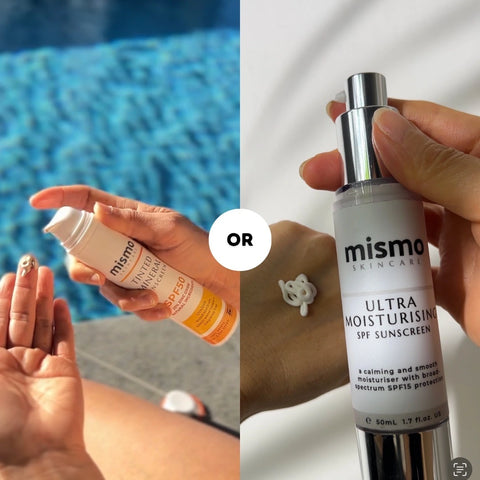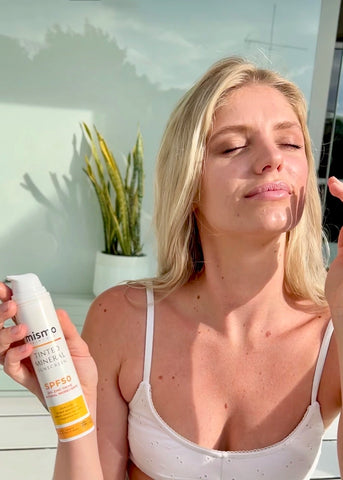
Battle of the Sunscreens: Ultra Moisturising SPF vs. Tinted Mineral Sunscreen
Are you ready to dive into the world of sunscreens? We've got two fantastic options that will keep your skin safe from the sun's harmful rays, but they come with their own unique features. Let's explore the differences and similarities between MISMO's Ultra Moisturising SPF Sunscreen and Tinted Mineral Sunscreen.
Ultra Moisturising SPF Sunscreen: Your Daily Defender
Similarities:
Both sunscreens provide broad-spectrum protection, shielding your skin from both UVA and UVB rays. This is essential for preventing sunburn, premature ageing, and reducing the risk of skin cancer.
Unique Features:
Ultra Moisturising SPF Sunscreen doubles as a soothing moisturiser, making it perfect for daily use. It's designed to keep your skin hydrated and calm with ingredients like hyaluronic acid, MSM, and vitamin B3.
This sunscreen has an SPF rating of 15, providing adequate protection for everyday activities. It's especially suitable for those with normal to oily skin types.
How to Use Ultra Moisturising SPF Sunscreen:
Apply to clean, dry skin 15 minutes before extended sun exposure. While not waterproof, it offers great protection for daily outings. For oilier skin types, it can even be used in the evening. For drier skin, consider switching to a richer night cream.
Tinted Mineral Sunscreen: A Youthful, Glowy Complexion
Similarities:
Both sunscreens are designed to provide high sun protection and are suitable for all skin types.
Unique Features:
MISMO's Tinted Mineral Sunscreen is SPF50, offering enhanced sun protection, reflecting around 98% of UVB rays. But what sets it apart is the subtle tint. This lightweight formula blends seamlessly into your skin, leaving you with a radiant complexion.
This sunscreen is ideal for those with sensitive, acne-prone skin, thanks to its non-nano zinc oxide content, which acts as a natural barrier against the sun's harsh rays.
How to Use Tinted Mineral Sunscreen:
Generously apply the sunscreen to all exposed areas 20 minutes before sun exposure. Reapply every two hours or more frequently if sweating or swimming.
Which One Is Right for You?
If you're seeking a daily moisturiser with sun protection for normal to oily skin, Ultra Moisturising SPF Sunscreen is your go-to. It's hydrating and soothing while offering SPF 15 protection.
On the other hand, if you want a higher level of sun protection with a touch of tint for a radiant look, Tinted Mineral Sunscreen is the choice for you. With an SPF50 rating, it's your best defence against the sun's rays.
Remember, when it comes to SPF, a higher number doesn't necessarily mean significantly better protection. Choose the sunscreen that suits your skin type and daily routine, and enjoy the benefits of staying safe in the sun!
The key difference between SPF15 and SPF50 is their level of sun protection. SPF15 provides moderate protection, blocking about 93% of UVB rays, while SPF50 offers much higher protection, blocking around 98% of UVB rays.
The duration you can be exposed to the sun depends on several factors, including your skin type, the UV index, and the level of sun protection you're using. SPF (Sun Protection Factor) indicates how much longer you can stay in the sun without burning compared to not using sunscreen.
For example, if you have fair skin that typically burns in 10 minutes without sunscreen, using SPF15 sunscreen theoretically allows you to stay in the sun for about 150 minutes (10 minutes x 15 SPF). However, it's important to note that sunscreen effectiveness decreases over time due to factors like sweating, swimming, or rubbing. So, it's advisable to reapply sunscreen every two hours or more frequently if you're swimming or sweating.
Always consider your skin type, the UV index in your area (which varies throughout the day), and follow the recommendations on your sunscreen product for the best protection. If you have fair or sensitive skin, it's a good idea to seek shade and wear protective clothing like hats and sunglasses for extra sun safety.



1 comment
For a drier, sensitive, older skin which SPF moisturiser is best, and is it used with anti aging moisturiser or instead of?